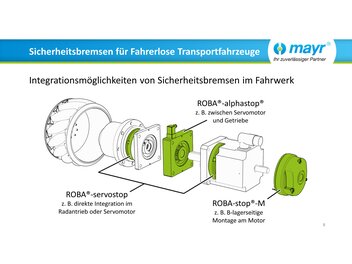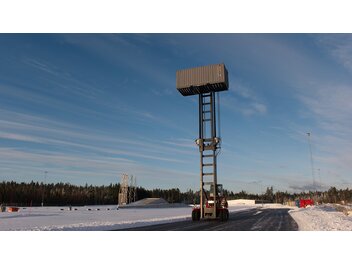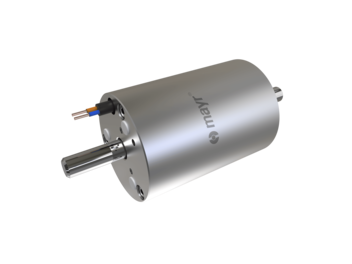The rising fuel costs and strict emission standards are currently also posing challenges for mobile construction machinery and logistics. With its new, high-performance electromechanical linear drives for forklifts, Cascade Drives from Sweden is setting new standards in the industry. The systems not only reach higher speeds when lifting and lowering the load, but also save energy in addition to CO2 emissions and meet all the requirements of functional safety. Also in use: Robust, reliable safety brakes by mayr® power transmission.
As is the case with all industries, also construction machinery, logistics and container handling are currently moving towards greater sustainability and energy efficiency. But how to combine this with the highest possible throughput, capacity and productivity? Will alternative drive systems be able to achieve the necessary forces, speeds and ranges or running times? Can electromechanical systems replace hydraulic ones? Cascade Drives, a company based in Sollentuna near Stockholm, Sweden, offers an innovative solution with its patented electromechanical linear cylinders. “In a wide variety of vehicles and machines, such as forklifts or construction machinery, e.g. excavators, the core functions (e.g. lifting or lowering) have so far been carried out using standardized or replaceable hydraulic cylinders,” Kristian Floresjö, CEO of Cascade Drives, explains. “But these systems waste energy because they are not always appropriately designed for the function at hand – one size or design just doesn't fit all customers. That’s why it becomes an essential part of the electrification to optimize those functions.” An example for this is a forklift truck for handling (empty) containers weighing up to nine tons. The twin lift mast has a total height of 18 meters and travels at a speed of 0.8 m/s. With the new linear drive, 64% of the energy used for lifting are recovered. This corresponds to total energy savings of 20% compared to conventional systems. “The patented Cascade Drives load-sharing system allows us to build compact high-performance actuators that can operate with high efficiency and over a wide velocity range – crucial properties for lifting operations”, Kristian Floresjö emphasizes.
Brake know-how for maximum safety
Two 230 kN linear cylinders are used for the lifting, each of which is capable of handling the maximum total load. “In order to achieve functional safety, we have joined forces with Mayr power transmission,” Kristian Floresjö explains. “The brake specialist provides us with systems that meet all our requirements and allow full redundancy.” If one cylinder fails, the second one can safely and reliably hold and brake the maximum load. “In several web meetings, we consulted with the experts from Mauerstetten and together we selected brakes that are safe and robust. We also carried out the calculations for e-stops together.” As a result, the robust ROBA-stop®-M motor brakes with closed brake housing in standard design are now used. If required for special applications, the brakes could also be delivered with corrosion protection.
Watch the lift function on youtube
Holding safely in position and braking
In normal operation, the brakes work as holding brakes: So once the drive has moved to a certain position, the brake holds it with millimeter precision, and reliably. But the brakes can also reliably stop the load from moving in an emergency. This is because the ROBA-stop®-M safety brakes by mayr® power transmission are electromagnetic safety brakes, which work according to the fail-safe principle. This means they are fail-safe. They are closed in de-energized condition, i.e. after a power failure or emergency stop. When the power is switched on, a magnetic field builds up in the brakes. The armature disk is attracted to the coil carrier against the spring pressure. This releases the rotor, which means the brake is released. In the event of malfunctions such as power failure or emergency stop, the ROBA-stop®-M brake reliably brings the load to a standstill within a very short period of time.
Short switching times and reliable switching condition monitoring
In particular for safety-critical and vertical axes, short stopping distances are important for the safety of people and machines. The brake switching times are decisive for the braking distance, because during the free-fall time until the brake closes and the retardation takes effect, the mass additionally accelerates – possibly to such extremes that the permitted brake values are exceeded. Users should therefore pay attention to verified switching times which are as short as possible when selecting safety brakes – and also assure themselves that these switching times can be maintained throughout the entire service lifetime of the brake. This is why reliable switching condition monitoring is key.
Here, mayr® power transmission offers an innovative solution for sensorless brake monitoring with the ROBA®-brake-checker module. The module (which can also be retrofitted) can monitor the switching condition of the brake and provide other critical information such as coil temperature, ppreventive function monitoring for wear, functional reserve and errors.
Furthermore, the ROBA®-brake-checker module provides regulated output voltage for different battery voltages and can also keep the overexcitation voltage constant. This allows excellent dimensioning of the brakes: It enables a stable supply of power to the brakes, even if the battery voltage drops or varies within the permissible range, and thus safe operation; the brake is still reliably supplied.
Controlling brakes intelligently and saving energy
And the control and monitoring modules from mayr® power transmission can do even more, as the performance density and energy efficiency of brakes do not only depend on design factors: A far greater savings potential is offered during operation through the intelligent control of the brakes. The brake is only energized with high voltage for a short time when it is switched on. In this phase, a high magnetic force is required. However, in subsequent operation, significantly less magnetic force is sufficient to keep the brake open. For this reason, the voltage can be significantly reduced, which also means less energy consumption.
Ratios of up to 2:1 between pull-in voltage and holding voltage are possible. If the rectifier lowers the voltage after the brake is released to half the value, the coil capacity and thus also the energy consumption drops to just one quarter. In other words, up to 75 percent of energy costs can be saved through optimum control of the brakes.








